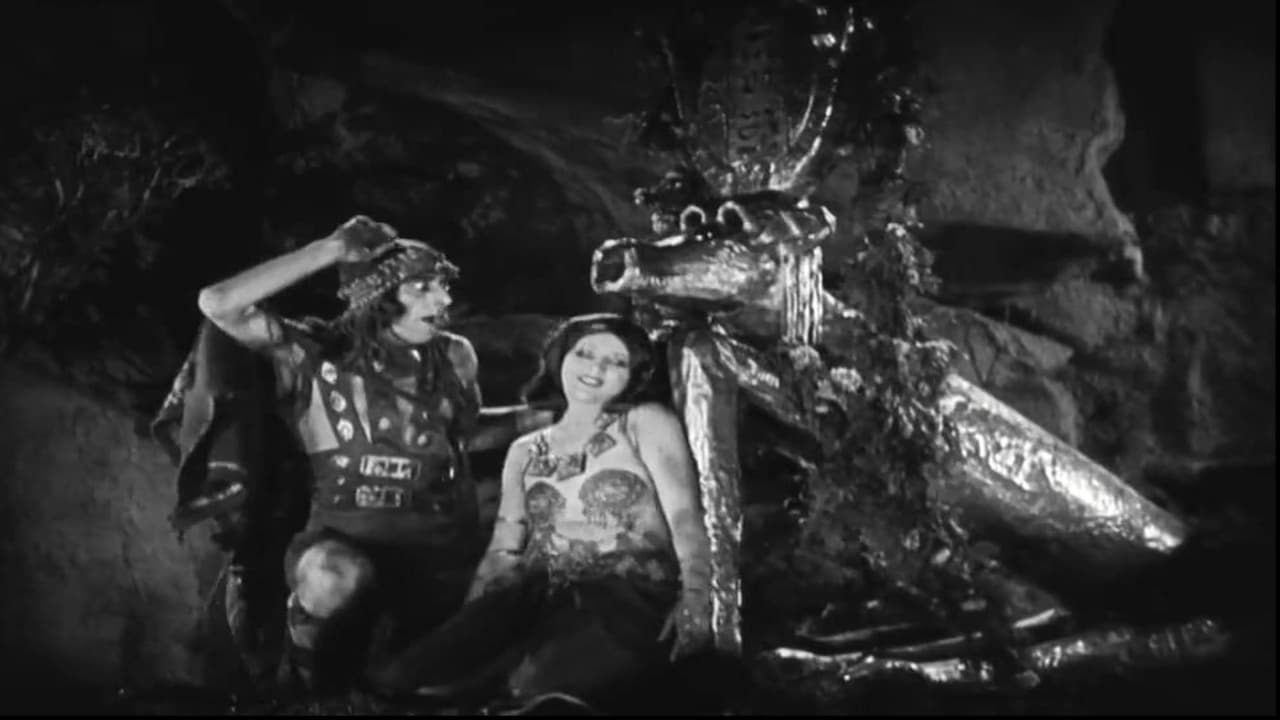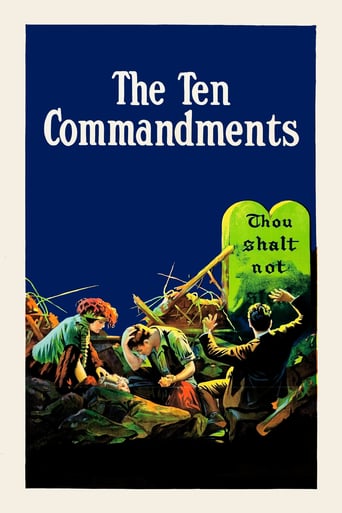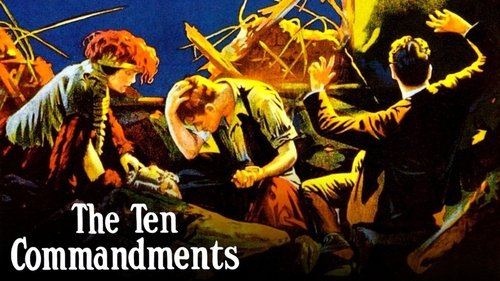


A Disappointing Continuation
... View MoreWhile it doesn't offer any answers, it both thrills and makes you think.
... View MoreThe movie really just wants to entertain people.
... View MoreI didn’t really have many expectations going into the movie (good or bad), but I actually really enjoyed it. I really liked the characters and the banter between them.
... View MoreTHE TEN COMMANDMENTS (Paramount, 1923), a super special production directed by Cecil B. DeMille, is the director's attempt in religious spectacle. Although DeMille already directed a story on Joan of Arc in JOAN THE WOMAN (1917), this is his attempt on doing something a little bit different from his previous efforts. As with the earlier silent classic of D.W. Griffith's INTOLERANCE (1916), consisting of four separate stories in no particular order, this edition to THE TEN COMMANDMENTS, unlike DeMille's most famous super four-hour 1956 edition starring Charlton Heston, this earlier 136 minute production combines Old Testament story according to Exodus followed by another story set in modern times. The Biblical portion, clocked at 50 minutes, as opposed to the modern-day story taking up much of the proceedings at 85 minutes, could have been a separate movie at best. With two movies for the price of one, THE TEN COMMANDMENTS simply shows God's Law being as relevant today as it was centuries ago.Opening Title: "Our modern world defined God as a "religious complex" and laughed at The Ten Commandments as OLD-FASHIONED. Then through the laughter came the shattering thunder of the World War. And now a blood drenched, bitter world - no longer laughing - cries for a way out. There is but one way out. It existed before it was engraved upon tablets of stone. It will exist when stone has crumbled. The Ten Commandments are not rules to obey as a personal favor to God. They are the fundamental principles without which mankind cannot live together. They are not laws they are the LAW."Prologue: Egypt, centuries ago, where slaves are seen pulling the wheels carrying a gigantic statue, with those getting whipped as they tire of such strenuous work. Ramesus, the Magnificent (Charles DeRoche) rules with no compassion while his sister, Miriam (Estelle Taylor) offers water to the abused slaves. Moses, the Lawgiver (Theodore Roberts), through the guidance of God's voice, leads His Children of Israel from bondage to the Promised Land. As Moses goes to Mount Sinai to speak to God in prayer, God answers him by posting on two tablets through volts of lightning his law he labels The Ten Commandments. In the meantime, his people are forsaking their God in favor of worshipping the Golden Calf. Modern Story: Widow Martha McTavish (Edythe Chapman) is an overly religious woman with two grown sons, John (Richard Dix), a carpenter, and Dan (Rod LaRocque), an atheist who fails to see his mother's logic in her beliefs. While eating at Dugan's Lunch Wagon, Dan encounters Mary Leigh (Leatrice Joy), a homeless young girl accompanied by her dog, out in the rain, stealing his food. Rather than having her arrested, Dan invites her to her home for dinner with the company of his suspicious mother and brother. Through the passage of time, John has fallen in love with Mary, but loses her to Dan. Dan doesn't prove himself a good husband as he practically breaks the Ten Commandments by having a mistress in Sally Lung (Nita Naldi) from Molokai Leper Island, and being the one responsible for one of his crooked deals by using bad concrete on a Cathedral he is constructing, and much more. For anyone expecting a near scene-by-scene original edition to DeMille's 1956 remake would be totally disappointed. The Biblical portion of the story shows great promise with lavish scale and costumes which makes one wish the entire story remained that way for about or under two hours. Theodore Roberts plays the white-bearded Moses to perfection, possibly his most famous movie role of his entire career. Special effects including the parting of the Red Sea is top notch, as is the visual style of the Ten Commandments flashing across the screen in full force. Though THE TEN COMMANDMENTS did prove successful in its standard form, the sudden change to modern theme seems out of place. For The Ten Commandments, it's the same then as it is today, which is what DeMille proposes to his movie audience of 1923. Those witnessing Edythe Chapman's performance as an overly religious and domineering mother could possibly relate to her character who has been raised in similar circumstance, with her forceful meaning turning away children from God rather than becoming closer. Rod LaRocque, who resembles that of actor Rudolph Valentino, convincingly plays the one who gets turned off by religion. Richard Dix, early in his career before his success in talkies and beyond, and he being the best known actor in the entire cast, should gather the most attention from movie buffs. And that's Agnes Ayres in a cameo playing an outcast for the modern story.Formerly presented on cable television's American Movie Classics (1993-1998), THE TEN COMMANDMENTS was also available on video cassette around the same time, accompanied by excellent organ score by Gaylord Carter. DVD with same scoring with crisp picture print condition features an added bonus of a commentary spoken by author, Katherine Orrison, whose historical accounts regarding this movie is most informative for those unfamiliar with THE TEN COMMANDMENTS according to DeMille. (***)
... View MoreEarly in this movie we learn that Egypt has already been visited by nine plagues, none of which we get to see. "What's the deal?" we ask ourselves. This is especially perplexing considering that the movie is two hours and sixteen minutes long. Even the tenth plague, the one where all of Egypt's firstborn die, is disappointing, for the deaths are only implied: We see the Pharaoh's son alive; later we see him dead. That's the last straw, of course, and so the Pharaoh tells Moses to take his people and get out.As we all know, people pick and choose the parts of the Bible they agree with and ignore the rest. One of the items people usually ignore is the one in Exodus 12:35-36, in which the Jews loot Egypt before they leave, taking the Egyptians' gold and silver jewelry and some nice clothes as well. Force apparently was not used. They simply told the Egyptians they only wanted to borrow the stuff, and the Egyptians fell for it because God put them in a lending mood. The intertitle in the movie says, "And they despoiled the Egyptians of jewels of silver, jewels of gold, and raiment." It was stealing, of course, but that's all right, because they hadn't yet received the Ten Commandments from God, one of which says, "Thou shalt not steal." So, they didn't know any better.It would have been nice if their "borrowing" the gold and silver had been depicted in the movie, but all we get is just one lousy intertitle. Immediately after, all you see is a bunch of people leaving Egypt. It makes you wonder why they even bothered to put it in the movie. It also makes you wonder if that was the real reason the Pharaoh changed his mind and chased after the Jews: "Hey! They borrowed our gold and silver jewelry, and I'll bet they don't intend to return it. Let's go get it back."We finally get some spectacle when the Jews come to the Red Sea. Not bad, considering. Then Moses climbs the mountain to receive the title commandments. While he is away, the Jews begin to party. And now we realize why it was necessary to include the part about the gold and silver. How else would the Jews have been able to make a Golden Calf? But it would have been crude to show the Jews actually stealing the stuff, so we get just enough information in the intertitle so we don't wonder where a bunch of slaves got all the gold to make a great big idol. In other words, an explanation for how the Jews got enough gold to make a Golden Calf was needed, but the embarrassing manner in which they obtained that gold is downplayed.Miriam, Moses's sister, displays much of her body and gets all sensual with the Golden Calf. Dathan, who is no good, starts to make love to her, but then he sees she has leprosy. Now, in the Bible, God does eventually inflict Miriam with leprosy because she objected to Moses marrying a black woman from Ethiopia, "Numbers 12," but in this movie, she gets inflicted with the disease during the Golden Calf party. Moses breaks the tablets in anger, Miriam begs him to heal her, and God lashes out with bolts of lightning, ending the party.It is at this point that we find out why we were shortchanged on the first nine plagues of Egypt. After only fifty minutes of screen time, with almost an hour and a half to go, the movie jumps to the present, and we discover that we have been watching a visualization of the story in "The Book of Exodus" as it was being read by a woman to her two adult sons, Johnny and Dan.At the beginning of the movie, there is a prologue that tells of how belief in God had come to be thought of as a "religious complex," and how people had come to think of the Ten Commandments as old fashioned. But then came the World War. "And now a blood-drenched bitter world—no longer laughing—cries for a way out." That way, of course, is the Ten Commandments, the Law without which men cannot live.The World War must have already worn off on Dan, however, and it isn't long before his mother turns him out of the house for being a no good atheist. What follows is a crazy plot in which Dan marries Mary, the two of them promising to break all ten Commandments.We don't see Dan and Mary making any graven images of God, but other than that, they do presumably break the other nine Commandments, and the juicy ones are actually depicted. Dan cheats on Mary, having an affair with a woman, Sally Lung, a woman half French and half Chinese. As for the Commandment, "Thou shalt not kill," Dan inadvertently does in his own mother when the cathedral he was building with shoddy cement collapses on her. And it turns out that the ship that brought in the cheap material for making that cement passed by an island that was a leper colony, from which place Sally Lung stowed away. Dan gets the disease, and he ends up giving it to Mary, just before he ends up dying in his effort to escape the law.Mary tries to run away to, possibly planning to kill herself, now that she has leprosy, but Johnny stops her. He reads to her from "The New Testament," telling her about love, and in the morning she is cured of the disease. This squares with the dying words of the mother, who said she was wrong to make religion to be about fear instead of love. But it doesn't exactly square with the prologue, which said the Ten Commandments, not "The New Testament," were what people needed following the World War.
... View Morethis is the first film version of The Ten Commandments.it is directed by Cecil B.Demille,who also directed the 1956 version.this version is very lean,going through the events of that time,very quickly.in 50 minutes,in fact.i'm guessing they just kept the essentials of the story,without anything extra.the special effects are quite something for that day.the film must have been a grand undertaking.the remaining 80 minutes or so is a morality play set in more modern times(around 1923,i'm guessing)concerning how the Ten Commandments relate to modern life,and what happens if we don't obey them.for me,this second half is just way too heavy handed and preachy.the message is a good one,but it feels like you're being hit over the head with sledgehammer.some of the acting may seem a bit exaggerated,but they had to act that way,since they didn't have sound.there is an orchestral accompaniment,that plays through out the film.the only problem is,i found the music too repetitive.it got annoying after awhile.still,considering that this movie was mad in 1923,it's not too bad.my vote for The Ten Commandments(1923)is a 6/10
... View MoreToday,all his epics ("ten commandments" 1 and 2,"sign of the cross" "Samson and Delilah" ...° have worn remarkably well.Like many people ,I saw the 1956 version well before the silent one.The prologue (which is very long for a prologue) has a plot similar to the 1956 version from the plagues to the golden calf orgy.Even the Parting of the Red Sea (and it's quite impressive for 1923!) and the writing of the Holy Tablets are here (it looks more like some kind of mystic firework here).As for the orgy,it's simply better than the color version.That said I like that latter version best,because the gap between the biblical tale and the modern one makes that the two parts do not hang very well,in spite of a brilliant transition : Moses and his people saga suddenly segues into a mother reading the Bible to her sons.The second part will deal with the story of two brothers,one of whom trying to break these "fusty" commandments and not be broken by them. There are interesting parallels: the workers on the building site and the slaves working for pharaoh on the pyramids,the hero who ,like "pharaoh's tribe ,is drowned in the tide" .Little by little,the film becomes slowly but inexorably overtly Christian: the momma hints to carpenters,nice carpenters,there's a short return to biblical times but depicting a scene of Jesus' s life and unlike the bad woman who became a leper in the prologue,salvation is around the corner for the evil millionaire's wife.Lines from St Matthew ("he gained the world but lost his soul") add to this feeling a redemption.Despite the reservations expressed above,De Mille was a storyteller extraordinaire,who equaled D.W .Griffith .Thou shalt not overlook him.
... View More